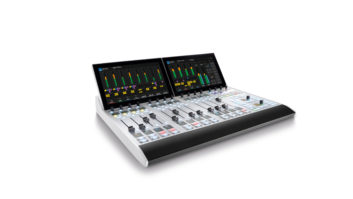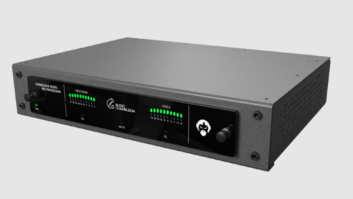From time to time, I have used this column space to reflect on larger trends within the radio broadcast industry. Over the years, RWEE has published articles from industry leaders about the developing importance of using Internet protocol as a means of transporting audio. As we near the end of 2013, it is time to acknowledge that we are well on the way to a widespread transformation of the radio business by IP audio.
NOBODY ASKED ME
While all the pieces for change have been years in the making, one recent precipitating event was the surprise announcement from Verizon in March that they would no longer provide ISDN service to customers in the form of the single line Basic Rate Interface (it is still possible to provision in other forms if you need a lot of ISDN capacity). When ISDN customers were informed, it was already too late to call in and complain — papers had been filed with regulatory agencies and arguments had been made that ISDN was no longer necessary. It’s hard to find the public in what was supposedly a public process, but to discuss this is like crying over lost cell phone calls. BRI ISDN is gone for about a third of the continental U.S. Even in other regions, it has been hard to get ISDN outside of metropolitan areas for some time. It’s hard not to believe the rest of the country is far behind.
THE GOLDEN AGE OF DIGITAL AUDIO
The past two-plus decades of ISDN service have been a sort of Golden Age of audio for radio stations and groups. National Public Radio and its affiliates, pioneers in the use of specialized codecs paired with serial digital data services, built national networks of locations with ISDN services to allow real-time, high-fidelity reporting from every corner of the United States. Nationally syndicated talk programs used similar networks to put guests of every specialty in a studio for live broadcasts and call-in shows. Even savvy media organizations (like Harvard University) began to install their own studios, equipped with ISDN, to allow reporters direct and easy access to star researchers and expert professors during breaking news events.
What made this happen? The completely standardized system developed by international regulatory groups with an interest in a completely interconnected telephone system. ISDN was a natural extension of the telephone companies’ basic product: the voice phone call. They understood that if you wanted to sell connection time by the minute, it had better well be possible for any user to connect to any other user. If you followed the standard, anyone’s equipment would just work because it was designed that way. Everyone could join this network for the cost of an ISDN line and a codec from any of their favorite manufacturers.
NEW KIND OF DIGITAL, NEW CHALLENGES
The public Internet was developed as a new kind of digital, based on techniques developed by the computer industry for networking massive numbers of computers, with distributed switching that offers redundancies conventional telephone systems could only dream about. To take advantage of these improvements, all you have to do is convert everything into Internet protocol.
A key difference between what we used to do with ISDN and what IP does now is that previously all communications required some kind of incredibly precise timing reference to be maintained across the entire network to decode the data. Computing power has increased so dramatically that we can now move data faster than real time and reconstruct it on the other side seamlessly for real time users. And it turns out to be much easier to transport data once you get rid of the requirement that the network all runs on one super-precise high resolution clock.
Easier and cheaper, too. But it creates challenges for the real-time user as it doesn’t always work properly. Since the first streaming audio was introduced in the mid-1990s, the IP audio industry has been trying to address those challenges in a satisfactory way. One method, guaranteed delivery of packets at the network level, has been very effective where the user has complete control of all parts of the network. It can and does deliver audio performance equal in quality to any real time systems. We now see all the leading audio manufacturers offering some form or another of studio IP audio for radio, including fairly large and complex systems. And buyers are buying them for their flexibility, performance and power.
What about national-scale networks? Telephones and ISPs are starting to offer delivery guarantees across larger metropolitan-sized networks. These systems, (e.g. MPLS) resemble the old T1 or T3 carriers in terms of being able to reliably deliver a contracted bandwidth or data rate — the difference is that it comes out in packets or as Ethernet protocol rather than as serial data. The downside of these services is they are a full-time contractual commitment. You pay the full price whether you use it or not. The cost of joining is high and only where you own both ends can you guarantee performance.
Which leaves the public Internet as the only choice for smaller users who want to join the network.
THE MEANS ARE OUT THERE
The audio industry, working within the real-time limitations of the public Internet, has developed a wide array of audio products that are now entering maturity. As much as I remain nostalgic for the certainty that ISDN provided, I am impressed with the new IP audio products enough to put them into regular usage for live events at my day job at WBUR.
As an example, we recently broadcast live a mayoral forum in Boston with a wired network connection on one IP codec and a second backup codec being fed by a router connected to two wireless 4G carriers. As usual, we analyzed the streaming statistics after the event was over. While a few years back I reported being burned by wireless connections, this dual-provider system actually worked almost as well as the wired. Audio quality was the equal of ISDN, and we went an entire two hours with virtually no problems on either path.
For STL applications, audio over IP on the public Internet has proven to be a huge money-saver and is beginning to come into its own. As long as there is no requirement for a return path to be used for audio contributions (like a two-way interview) users are finding that with enough buffer, even a poor IP connection can deliver acceptable performance as long as some kind of backup is available for when the network goes down (and all the cheap ones do, about once per day, in my observation of the statistics). IP audio is ready for radio and is already changing the way we do business.
LET THERE BE METHOD IN IT
There remains just one problem with this transformation, and it is holding back a flood tide of change. The IP audio industry was developed through the initiatives of many individual companies, each working in their own way. Not all of these companies came from a “traditional” audio background. Indeed, the early days of streaming audio led to many Khrushchev moments, shoes pounding on the table with cries of “We will bury you!” addressed to the elders in the broadcast business by goateed 20-somethings whose main qualification was having dropped out of college. Arguably, this is one of the reasons for the considerable rush to consolidation in radio industry ownership as a defensive measure. But the highly competitive environment resulted in the current state of IP audio madness. Compatibility was not a defining goal, but was at best, an afterthought as various folks worked to “own” the entire IP audio market.
It’s easy to understand why most products on the market today contain proprietary “hooks” that render them unable to connect with their competitors — after doing the hard work to get something that would operate well, it wasn’t easy to then share that knowledge with others. Some manufacturers came to the game working within internal studio networks only, not expecting to encounter compatibility problems. And then there were always those college dropouts on every corner, looking to grab a good idea and build the next Facebook.
This current Tower of Babel hurts the IP audio industry. It’s time to open up full, not partial, compatibility between units and cooperate on making it work. Standardization built one Golden Age of audio. Now it’s time to extend that to IP audio and begin work on the second, which promises to be even bigger.
Michael LeClair is chief engineer for radio stations WBUR(AM/FM) in Boston; he has been technical editor of Radio World Engineering Extra since its inception in 2005.












